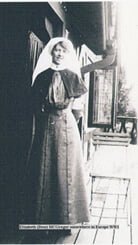Quarantine Station
The North Head Quarantine station location was originally home to the Gayimai people, with Old Man’s Hat being a significant meeting and eating place. Three days after the First Fleet arrived, Captain Hunter and Lieutenant Bradley met with some of the Gayimai custodians on Quarantine Beach on 29 January 1788.
Every time a ship arrived into Sydney Harbour there was a risk of disease spreading. The North Head Quarantine Station operated from August 1832 to February 1984 and was Australia’s longest continuously operating quarantine station. The area is now known as Q Station and is home to a hotel, conference centre and restaurants. Daily historical tours are available, worth while to make a reservation.
Quarantine Station
The Station was established to mitigate the risk of disease importation through the migration of free and convict immigrants to Sydney. When the majority of ships requiring quarantine were convict transport it was easy to enforce quarantine as they were under government contract. From 1831 free vessels arrived at an increasing rate with their captains less willing to comply with a request for quarantine, resulting in a legislated requirement, the 1832 Quarantine Act, for all ships entering Sydney Harbour to be screened for disease and quarantined as required.
Initially ship captains had to declare if the ship harboured disease, the consequence being the sick remain housed on board and the departure of the ship was postponed, resulting in a delay in the ship being operational. Time spent was and is money lost. Many ship captains, desiring a quick turnaround declared their ship was disease free - when it wasn’t.
Later the declaration of disease was made by the ship’s doctor or surgeon-superintendent and the Quarantine Station permanent accommodation was established so the ship could be fumigated, cleaned and turned around quickly for new work.
In parallel, a review of the conditions of ships bringing immigrants was undertaken by the NSW government, much to the annoyance of the British. It found there was insufficient checking of the health of emigrants before boarding, insufficient focus on diet whilst on board (particularly for children; three children equalled an adult in terms of food and space) and the need for the surgeon-superintendent to have more authority to regulate and promote good health whilst passengers were on board. Significant changes such as medical checks, smallpox vaccinations, improvements in diet and hospital accommodation onboard, a reduction in overcrowding and clarification and more authority of the surgeon-superintendent’s role at the British end resulted in far less deaths and disease.
The tour
Our lovely tour guide, Brandon, started at the bottom of the site, where all those travellers landed. The first sight was rock carvings showing ship names and dates. The Niagara introduced the Spanish Flu to Sydney and 5 - 600 people were quarantined.
The autoclave
When the sick or healthy weary travellers arrived their luggage was put through an autoclave, using 115 degree steam to kill any germs. Most luggage was made of cardboard so left the autoclave in a sad state. There were also two treatment rooms that released zinc sulphate steam to 40 people at a time.
The shower
Every person considered in need of decontamination was showered in hot water with phenyl carbolic acid. They entered through one door, exited through another with little communication about what and why. There were compartments in the shower. The first was where clothes were placed in a wire basket and taken away, then they stood in a pit to shower. A peephole was used by the guards to ensure people showered. They would lose 1 - 2 layers of skin as a result of the chemicals.
This is a first class shower, the second and third classes were waist high.
This process was used until the 1980s, imagine being a post WWII European and going through those doors!
The hospital
We wandered up to the hospital which had a healthy and unhealthy area. The only people to cross between the two were grave diggers who measured the dying for their coffin, which was then placed under their bed in readiness.
Two volunteer nurses
Two nurses Elizabeth McGregor and Annie Egan volunteered early to tend the sick. Annie began nursing soldiers and crew of the Medic with Spanish Flu from 21 November 1918. Annie quickly contracted the disease and joined her patients in hospital on 26 November. She was a devout Catholic and requested the attendance of a priest for a final confession and the last rites, which was refused. She died 3 December 1918 and was buried with full military honours including a march past of all soldiers well enough to attend. Fresh flowers are still put on her grave every anniversary.
Elizabeth had nursed soldiers in WW1, surviving dysentery and malaria in France. She died at the Quarantine Hospital 5 December 1918.
The doctors
Two prominent doctors, Dr Charles Reid, Quarantine Officer from 1909 - 1927, 6’8'“ tall and Dr Fox, known as ‘The Long and The Short of It’. Dr Reid was popular during his posting and helped to improve conditions. He was killed in the Greycliffe ferry accident which collided with the ship Tahiti.
The hospital was small and would have been dreadfully overcrowded with the sick and dying. There are marks in the table where onions were cut up to rub on hands for sterilisation.
No information is available as to how many people lived or died and many graves are unmarked. It is thought over 2000 people are buried in the three graveyards but there’s no evidence. 583 ships were quarantined. Harsh and unimaginable and a great, informative day.






















